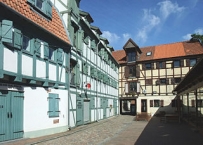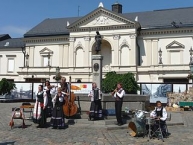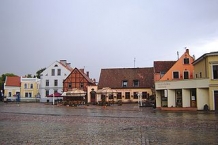Cycle Tour Iron Curtain Tour, part 2, Klaipeda-Gdynia
Travel report: From Lithuania via Kaliningrad (Russia) to Poland
Actions
![]()
Please wait - map data are loading
Added on 22 Jan 2019,
last edited by Ottocolor on 28 Feb 2020
Actions
Cycle route metrics
planned
ridden
Total distance in km
337
311
Cumulative elevation gain in m
2.197
1.708
Avg. slope uphill in %
0,65
0,55
Cumulative elevation loss in m
2.192
1.714
Information about rights to the gps-track data | |
|---|---|
Rights owner | |
Rights characteristic / license | cc0: Public Domain no Rights reserved |
Link to the description of the license | |
GPX file uploaded | by Ottocolor on 07 Mar 2019
|
Track points in total
3.879
4.470
Track points per km (avg)
9
14
Start/endpoint
Start location
Klaipėda, Klaipeda County, LT (1 m NHN)
End location
Gdynia, Pomeranian Voivodeship, PL (6 m NHN)
Character
Information about copyright | |
|---|---|
Rights characteristic / license | by-sa: CREATIVE COMMONS Attribution-ShareAlike |
Link to the description of the license | |
taken over / edited on | 22 Jan 2019 - 07 Mar 2019
|
taken over / edited by |
|
Landscape
My cycling holiday in May 2019 leads me and my bike through coastal scenery along the easternmost Baltic Sea from Lithuania via Russia to Poland. A specialty over here are long sandy spits (the Curonian spit is almost 100 km long), which lie outside the old coastline and thus form large fjords. The second spit is called the Vistula Spit. And they are both divided in the middle between two countries, respectively. Lithuania / Russia and Russia / Poland. The Russian part of the Vistula spit is blocked for the public. mainly due to a military area around the city of Baltiysk. The Curonian spit I intend to ride in its full length, while I set over to the Vistula spit and cycle approx. 20 km of its length. They are both very sandy with very high dunes, large dune plantations to keep on the sand and a fine sandy beach as far as the eye can see. The starting point of my tour is a crossing of the Baltic Sea from Karlshamn in Sweden to the old German Hanseatic city of Memel, which has been called Klaipeda for 101 years now, because it is in Lithuania. But the German empire spread this far. Funnily the German border village north of Memel was called Nimmersatt. That means "never satisfied". One may think that when you're never satisfied, you eventually lose everything again. What the Germans then did in two stages after two lost world wars they had started themselves, so today the eastern border of Germany runs over a thousand kilometers further west near Swinoujscie. Another fact is that the Russian Kaliningrad region, which I cycle into on the second stage, once again is an exclave, ie. it is not connected to the Russian motherland to the east, just as it was in Germany between the world wars. At that time it was called the East Prussia and Kaliningrad was named Königsberg. It means the King's hillI, and that's because it was the Prussian kings' crown town and residence town along with Berlin. Russia is the core of my cycling holiday, although I only stay here for three days. Not much when you consider that the visa to Russia cost me around 1250 Danish kr. The first stage is thus in Lithuania. Here, the spit fs a national park with a first-class bike path and lovely little towns on the fjord side. My goal of stage 1 is the largest town, which is not big, Nida. Here The world famous German writer Thomas Mann ("Die Buddenbrooks") owned a cottage, which today is a museum for his memory. The first Russian stage goes from the border town of Nida (in the middle of the spit) to Svetlogorsk on the north coast of the Sambian peninsula. Like Zelenogradsk (Cranz) further east, it was a German seaside resort and was called Rauschen. There is still some old German seaside architecture left behind, of course rebuilt after the devastation of war and the neglect of Soviet times. Here the coast is quite high and steep. There is even a cable car from the railway station in Svetlogorsk down to the beach, which is quite narrow here, but still sandy. On the third day, I cycle on to the destination city of Kaliningrad, hopefully via the town of Yantarnyj in western Sambia. "Yantar" means "amber" in Russian, and it is not false advertising, because the city has a giant big open mine and produces about a third of the world's raw amber. The exploitation of the amber deposits has a long tradition, of course also in German time and has contributed to the wealth of Königsberg / Kaliningrad. Then I cycle over the hilly Sambian peninsula, which lies between the two fjords behind the two long spits. It is going to be a bit special to cycle into Kaliningrad, just under half a million inhabitants. The Russians are not used to bicycles outside the cities, so care must be taken. Inside the cities, however, a lot of cycling goes on, so here one's right to existence can be claimed, but of course traffic is entirely on the premises of the cars. So it will be nice to cycle through a few parks, including the Victory park (Park Pobedy) in honour of the Soviet Union's victory in World War II. And coincidentally the day after it ieally is Victory day (Dyen Pobedy), May 9, which is a great day of celebration in Russia. Probably a parade is staged in this victory park and in the city as such. This day is even a day of rest, because I have booked two nights at the very centrally located hotel "Skipper". Its name proves the city's proudness of the its maritime flair and the district in which it is located, they call the "Fishermen's Village" (Rybnaja derevnja). Here are a few old houses are resurrected in old style and give the city a bit of historical flair. Which it completely lost during and after the war, which turned out a pure disaster for the city's German population. The German "Gauleiter" Erich Koch had closed the city and declared it a fortress. This resulted in thousands and thousands of innocent victims when Soviet artillery and tanks broke into the ancient and beautiful Hanseatic city. The following year, the remains of Königsberg were named after the then Soviet Union president Mikhail Kalinin, one of Stalin's loyal men. A few years ago, there was an indicative referendum in town about whether it should have its old name back (like Leningrad / St. Petersburg), but the proposal fell by a small majority. After the end of the war, the new Russian rulers were hard at the city and its German inhabitants. The survivors were all expelled, and not many houses were rebuilt in original style or allowed to remain. An exception is the cathedral (Kafedralnyi sobor), which houses the tomb of philosopher Immanuel Kant. It is located on the island of Kneiphof (now called Kant Island) between two arms of the river Pregolya. The royal palace, which was no more damaged than it could have been repaired, was demolished, and a giant colossus of a concrete block, the House of Soviets, was erected instead. In my eyes one of the world's largest eyesores. In recent times, an archaeological excavation has been made on the site, which has exposed some of the cellars of the castle. Along with the cathedral, a couple of the city's gates are also preserved. One of them houses the amber museum. An obvious opportunity for a visit. And I guess I'll have at ride to the new football stadium, where last year I saw a match during the football World Cup with my sons. Maybe there is a party going on out there on the "Victory Day"? The end of the cycling holiday is devoted to Poland. To get along quickly, I grab the suburban train to the border town of Mamonovo, which was called Heiligenbeil in German time. Here I cross the border back to the EU. Shortly after, I reach Frombork at the Wisla Fjord. This city was probably worth looking into as it was Nikolaus Kopernikus' hometown, and his observatory is preserved. But, at best, I only catch a glimpse of it all before I take the ferry Monika to Krynica Morska on the Vistula spit. Here I hope for anything but strong west wind, because I want to go all the way to Sobieszewska Island close to the city of Gdańsk. Along the way, I cross the canal of the Vistula mouth by a ferry that does not run in strong winds. Originally, the Vistula River (in German Weichsel, in Polish Wisla) flows into the Baltic Sea iby way of a very large river delta. Today, most of the arms are "dead" (one is even called "Dead Vistula" (Martwa Wisla) or fed by other rivers. There is a small history of the Vistula fjord and spit. As the fjord's exit lies in Russia (at Baltiiysk), the Poles have plans to dig a canal trough through the spit to have an exit for ships to the Baltic Sea, but environmental concerns have so far postponed the plans. At the end of the day I have hopefully pitched my tent at the "Eagle's Nest" campsite on the Sobieszewska island inside the city borders. Together with Nida on the first stage it is the only two nights I sleep in my tent. The island is a nature reserve and some of a bird's paradise. But I won't have an eye for that as I "haste towards another old German Hanseatic city in Slavonic hands, namely Gdańsk / Danzig. It is only slightly smaller than Kaliningrad, but is much more well preserved. Thank goodness it was not nearly as devastated 74 years ago. It is said to be a very beautiful city with a very large cathedral in the Baltic Sea gothic style, which is seen all the way from Riga to Lübeck. In addition to it, the old river port with the wooden crane and "The Long Square", which is surrounded by beautiful old citizen houses with the gable facing the square, is worth seeing. In fact much more is, and I know that I will miss more time here, but I need to ride some 30 km more to Poland's largest port town of Gdynia, from where I'll take the Stena ferry back across the Baltic to Sweden. On the way there, I cycle through the seaside resort of Sopot, and I have thus been in all three cities that are gathered in the city region "Three city" (Trojmiasto). Gdynia is called Gdingen in German. It was too strange for the Nazis who called it Gotenhafen. Here one of the worst tragedies of the Second World War unfolded, when in January 1945, the refugee ship of Wilhelm Gustloff departed from here with desperate German refugees fleeing from the Soviet army. A few miles out on the icy Baltic Sea it was torpedoed by a Soviet submarine and sank. An unknown number of people, including many children, drowned, perhaps as many as 10,000. The submarine commander was called Marinesco. He is a hero in Russia even today, and in many cities, also in Kaliningrad, there are places and streets named after him. War is truly a relentless and inhuman size. Fortunately, I do not have to fear such a mischievous fate, but can rest my head on a soft pillow and sleep safely before I wake up outside Karlskrona. The cycling holiday "Iron Curtain Trip, Part 2" is over. Read more and see pictures when I have uploaded ithem during summer.
Information about copyright | |
|---|---|
Rights characteristic / license | by-sa: CREATIVE COMMONS Attribution-ShareAlike |
Link to the description of the license | |
taken over / edited on | 18 May 2019
|
taken over / edited by |
|
Travel to and from ...
OUTBOUND: Train Odense-Karlshamn, ferry Karlshamn-Klaipeda.
HOMEBOUND: Ferry Gdynia-Karlskrona, train Karlskrona-Odense.
Stages
Information about copyright | |
|---|---|
Rights owner | |
Rights characteristic / license | by-sa: CREATIVE COMMONS Attribution-ShareAlike |
Link to the description of the license | |
Image has been uploaded | by Ottocolor on 18 May 2019
|
69 km
Klaipeda-Nida
Information about copyright | |
|---|---|
Rights owner | |
Rights characteristic / license | by-sa: CREATIVE COMMONS Attribution-ShareAlike |
Link to the description of the license | |
Image has been uploaded | by Ottocolor on 18 May 2019
|
64 km
Nida-Svetlogorsk
Information about copyright | |
|---|---|
Rights owner | |
Rights characteristic / license | by-sa: CREATIVE COMMONS Attribution-ShareAlike |
Link to the description of the license | |
Image has been uploaded | by Ottocolor on 19 May 2019
|
59 km
Svetlogorsk-Kaliningrad
Information about copyright | |
|---|---|
Rights owner | |
Rights characteristic / license | by-sa: CREATIVE COMMONS Attribution-ShareAlike |
Link to the description of the license | |
Image has been uploaded | by Ottocolor on 19 May 2019
|
Hviledag/rest day Kaliningrad
Information about copyright | |
|---|---|
Rights owner | |
Rights characteristic / license | by-sa: CREATIVE COMMONS Attribution-ShareAlike |
Link to the description of the license | |
Image has been uploaded | by Ottocolor on 19 May 2019
|
66 km
Kaliningrad-Wyspa Sobieszewska
Information about copyright | |
|---|---|
Rights owner | |
Rights characteristic / license | by-sa: CREATIVE COMMONS Attribution-ShareAlike |
Link to the description of the license | |
Image has been uploaded | by Ottocolor on 19 May 2019
|
53 km
Wyspa Sobieszewska-Gdynia
Beds4Cyclists, worth visiting and infrastructure
Name and address
Latitude / Longitude
Phone
Fax
Mobile
Type of accommodation
Rating for cyclists
Route km
Dist. to route
Elevation
2 km
0,1 km
5 m
5 km
0,2 km
9 m
5 km
0,2 km
5 m
6 km
0,0 km
10 m
Hours of opening
October – April: Monday – Friday 9.00-18.00 h
May: Monday – Friday 9.00-18.00 h, Saturday 10.00-16.00 h
June – August: Monday – Friday 9.00-19.00 h, Saturday – Sunday 10.00-16.00 h
September: Monday – Friday 9.00-18.00h, Saturday 10.00-16.00 h
Languages spoken:
lietuvių kalba
6 km
0,0 km
9 m
Information about copyright | |
|---|---|
Rights owner | |
Rights characteristic / license | by-sa: CREATIVE COMMONS Attribution-ShareAlike |
Link to the description of the license | |
Image taken over from | commons.wikimedia.org/wiki/File:Klaipeda-Stadtrundgang_02.jpg |
Image has been uploaded | by biroto-Redaktion on 04 Nov 2011
|
Information about copyright | |
|---|---|
Rights owner | |
Rights characteristic / license | by-sa: CREATIVE COMMONS Attribution-ShareAlike |
Link to the description of the license | |
Image taken over from | commons.wikimedia.org/wiki/File:Klaipeda_-_Annchen_von_Tharau_with_Folklore_Group.jpg |
Image has been uploaded | by biroto-Redaktion on 04 Nov 2011
|
Information about copyright | |
|---|---|
Rights owner | |
Rights characteristic / license | by: CREATIVE COMMONS Attribution |
Link to the description of the license | |
Image taken over from | commons.wikimedia.org/wiki/File:Klaipeda_Theaterplatz_Ost.jpg |
Image has been uploaded | by biroto-Redaktion on 04 Nov 2011
|
Klaipėda (German: Memel) is a city in Lithuania situated at the mouth of the Danė River where it flows into the Baltic Sea. It is the third largest city in Lithuania and the capital of Klaipėda County.
The city has a complex recorded history, partially due to the combined regional importance of the Port of Klaipėda , a usually ice-free port on the Baltic Sea, and the Akmena - Danė River. It has been controlled by the Teutonic Knights, the Duchy of Prussia, the Kingdom of Prussia, the German Empire, the Entente States immediately after World War I, Lithuania as a result of the 1923 Klaipėda Revolt, and the Third Reich following the 1939 German ultimatum to Lithuania. The city was incorporated into Lithuania during its tenure as a Soviet Socialist Republic and has remained within Lithuania following its re-establishment as an independent state.
Historical
Klaipėda's main attractions are the historic buildings in the city's centre, dating from the 13th to 18th centuries. Some of its older buildings have picturesque half-timbered construction, similar to that found in Germany, France, England, Denmark and southern Sweden. Other places of interest include:
- The remnants of the Klaipėda Castle
, built in the 13th century by the Teutonic Order. It had a massive bulk and a quadrangular tower, surrounded by the ramparts and brick bastions. It lost importance after the Russian occupation from 1756 to 1762, and thenceforth started to decay.
- The Žardė ancient settlement, situated on the right bank of the Smiltelė River. It is dated to the late Iron Age (10th century), and was inhabited until the 16th century.
- The remnants of the so-called 'Dutch' defence system around the entire town from the 17th-18th centuries.
- The maritime museum in Fort Wilhelm, built at the end of the 19th century at the spike of the Curonian Spit.
Museums
Information about copyright | |
|---|---|
Rights characteristic / license | by-sa: CREATIVE COMMONS Attribution-ShareAlike |
Link to the description of the license | |
Input taken over from: |
Wikipedia contributors, 'Klaipėda', Wikipedia, The Free Encyclopedia, 7 March 2012, 13:06 UTC, http://en.wikipedia.org/w/index.php?title=Klaip%C4%97da&oldid=480656813 [accessed 8 March 2012] |
taken over / edited on | 08 Mar 2012 - 25 Aug 2016
|
taken over / edited by |
|
![]()









